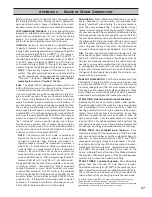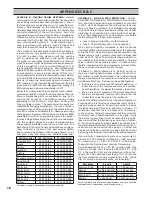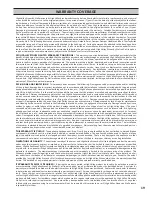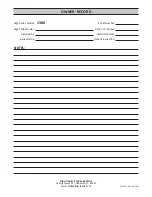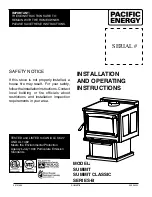
17
A
̴
B
W
C
Before striking a match to light that
fi
rst
fi
re please read
the following informa on outlining the basics needed for
clean wood combus on. Space is limited here, but much
has been wri en on the subject and is available elsewhere.
T C
T
:
Air, Fuel, and Igni on are
required to establish and support combus on whether
wood, coal, wood pellets, gas, oil, etc. is the fuel being
burned. The correct propor on of air and fuel will vary,
but the three basic ingredients essen ally the same.
I
:
Igni on in a wood heater is straigh orward.
Typically it involves a match, paper, and kindling wood.
Enough heat must be generated and sustained to get the
cord wood burning (@ 350°C to 500°C**). For compari-
son matches are es mated to burn at 600°C to 800°C; a
standard butane lighter is somewhat ho er at @ 800°C
to 1100°C, paper will ignite at @225°C to 250°C and dry
so wood kindling at @350°C. You light the paper with
a match to ignite the kindling and,
fi
nally, the cord wood.
NOTE:
There are any number of "
fi
restarters" on the
market. They light easily with a match and eliminate the
need for newspaper. We recommend the clean burning
"food safe"
fi
restarters.
NEVER use any type of
fl
am-
mable liquid to start or "freshen" the
fi
re.
F
:
The Model 1300 is designed and approved for use
with solid natural wood. Use of any other fuel may create
excessive emissions and will void the warranty.
The cord wood that you will burn depends to a large de-
gree on what species of trees are abundant where you
live. Transpor ng hardwood from its source to an area
where hardwood is scarce would be cost prohibi ve. If
you live where only so wood species are available, then
that is what you will likely use for fuel. In fact all cord
wood, regardless of species, has approximately the same
poten al BTU's* in each pound of wood. A pound of so -
wood has the same poten al @ 8600 BTU's (kiln dry) per
pound as a pound of hardwood. "Hardwood" is denser
than "so wood", varies in speci
fi
c gravity, and is there-
fore heavier by volume; and, of course, wood is sold by
volume, not by the pound A cord of hardwood will take
up the same space as a cord of so wood but it will be
heavier and contain more poten al BTU's.
NOTE:
The common unit for the sale or purchase of
fi
rewood is the cord. One cord equals 128 cubic feet
(4' high x 4' wide x 8' long). Because cord wood is ir-
regularly shaped it would be impossible to achieve a
solid 128 cu. . block of wood. Wood is supposed to be
"well stacked" in a proper cord but that is a subjec ve
measure. 85% wood and 15% air space is commonly
accepted as the proper ra o but some sources cite 70%
wood and 30% air space. That represents signi
fi
cant dif-
ference of @ 109 cu. . to @ 90 cu. . of usable wood.
Along with density, the other major variable in wood fuel
is moisture content. Unseasoned or "Green" wood will
contain 50% water or more. Good "air-dried" cord wood
is about 20% moisture. At 20% moisture the available
BTU's will be @ 6200 to 7000 per pound not 8600. At 50%
moisture "green" wood will have only @ 4000 BTU's per
pound or less. It follows that cord wood needs to be well
seasoned. It may take 9 months for so woods and up to
24 months for hard woods to air dry thoroughly.
C
:
Clean, e
ffi
cient combus on in your wood
heater depends on good quality, well seasoned fuel.
Buying "seasoned" wood during the burning season is
most o en very disappoin ng. The best advice is to get
"green" wood in spring and air dry it yourself. If you don't
cut your own wood,
fi
nd a reputable, reliable wood seller.
So wood species may be dry enough for use by the fall of
the year while hardwoods may not be well seasoned un l
the following fall. Stack the wood o
ff
the ground in a well
ven lated area, preferably under cover or, at the least,
with a tarp over the top of the stack. More informa on
on wood and wood species see Appendix - B on Page 18.
A :
The other leg of the combus on triangle is air. The
air needed to support combus on is drawn into the
fi
re-
box by the dra of your chimney. (See Page 6) Final air
delivery and metering required much research and engi-
neering to ensure clean combus on but, the good news
is, you regulate the combus on air with one damper. As
long as your chimney dra s well, air control is simpli
fi
ed.
It is against federal regula ons to alter the air control set-
ngs or controls in any way.
S
C
:
Put the three elements of the
Combus on Triangle together in your wood heater and
you will have started a
fi
re. The chemical and physical
processes taking place in that
fi
re are complex, and scien-
fi
c papers on the subject are lengthy and detailed. Three
major stages are worth no ng and will help the operator
understand how to achieve the cleanest burning
fi
re.
STAGE ONE:
K
M
E
:
Kindling the
fi
re has been covered above under Igni on.
Provide enough heat to the wood for a long enough me
and it will begin to burn. Before the
fi
re can reach full
hea ng poten al moisture in the wood must be evapo-
rated. This is why dry fuel is so important. More than
1000 BTU of poten al heat will be needed to drive o
ff
each pond of water. Un l the water present in the wood
is boiled o
ff
the
fi
re will be rela vely cool, heat from the
coal bed will be used up, and
fl
ue gas temperatures will
be reduced. Burning green wood wastes a lot of energy.
STAGE TWO:
G V
I
:
Once
moisture is driven o
ff
, the temperature of the
fi
re builds
and various hydrocarbons and other elements begin to
vaporize. At temperatures between 540°F and 1225°F
these gasses will ignite if oxygen is introduced. The stain-
less steel tubes at the top of the
fi
rebox meter in air auto-
ma cally to ignite those gasses. Temperatures approach-
ing 2000°F are possible, providing more heat to the
home. A blueish
fl
ame at the top of the
fi
rebox indicates
the burning of
fl
ammable gasses. If the
fl
ames disappear
prematurely increase the air damper se ng.
STAGE THREE:
C
B
:
A er
fl
ammable
gasses have been burned o
ff
, only charcoal remains.
Charcoal burns cleanly at @ 1100°F in the presence of ox-
ygen. Adjust the air damper as needed to extend the
fi
re.
If a con nuous
fi
re is desired, add fresh fuel while the
charcoal bed is s ll hot enough to kindle the new wood.
*
A Bri sh Thermal Unit (BTU) is a measure of the amount of energy
(heat) required to raise one pound of water by 1°F at sea level.
**The temperatures are given in Celsius and the temperature ranges are
approximate as the values vary from source to source.















